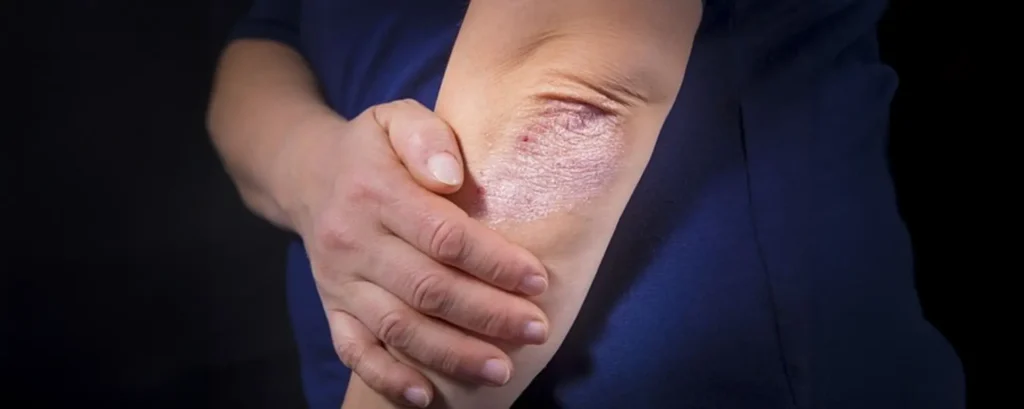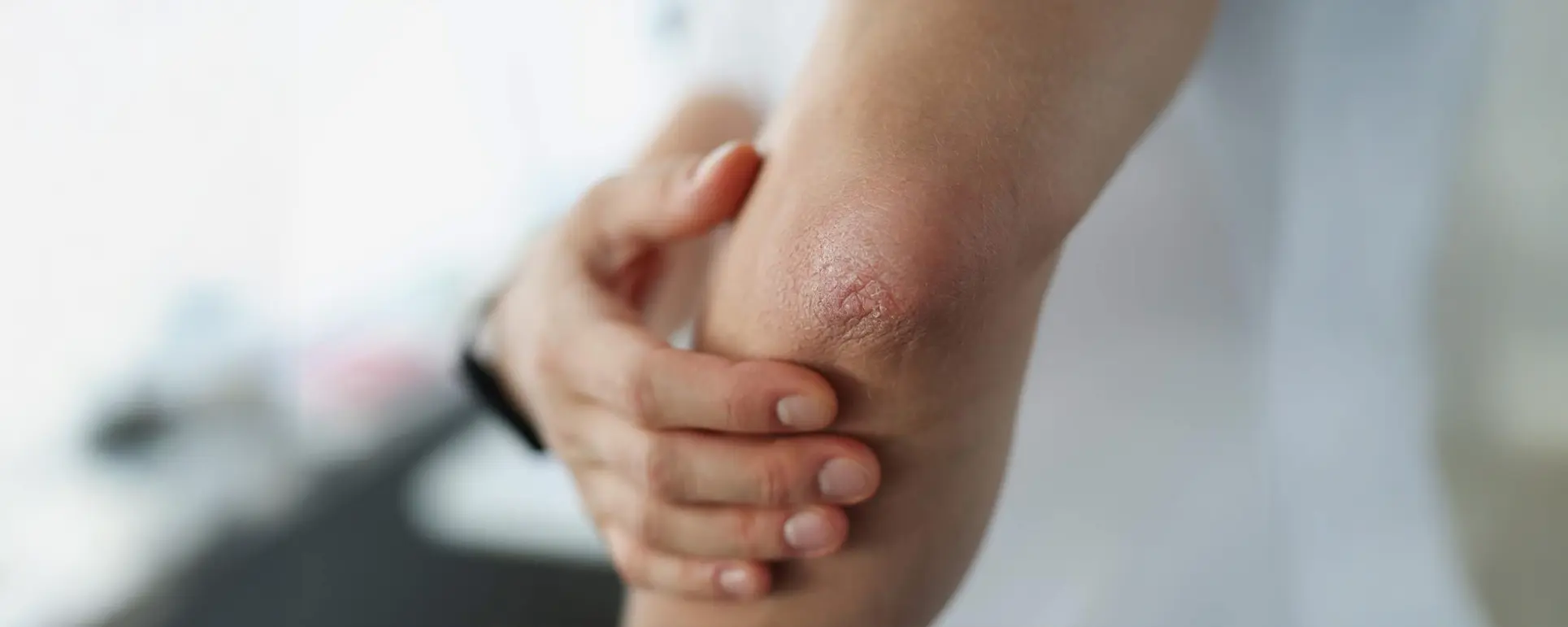Have you ever noticed a rough, thickened patch of skin on your elbow, knee, or even the back of your neck and wondered what it really is? Many of us brush it off as simple dryness, a bit of irritation, or the result of leaning on hard surfaces too often. You might even reach for a moisturiser, hoping it will smooth things out in a few days. But what happens when that patch doesn’t go away, keeps getting thicker, or starts to itch so much that you find yourself scratching without even realising it?
These kinds of skin changes are more common than you might think, and while they can seem harmless, they sometimes point to specific skin conditions. One possibility is lichen simplex chronicus, a condition that develops when repeated scratching or rubbing causes the skin to become leathery and raised. But that’s not the only culprit. Similar rough patches may also be linked to eczema, where the skin barrier becomes inflamed and overly sensitive, or psoriasis, which is an immune-related condition that speeds up skin cell turnover and causes scaly plaques. Each of these problems has its own triggers, patterns, and treatment approaches.
The tricky part is that to the untrained eye, they can all look like the same thing: a stubborn, itchy, and sometimes discoloured patch of skin that just won’t budge. That’s why paying attention to the details like whether the area is more itchy than painful, whether it looks scaly or leathery, and whether similar patches appear elsewhere on the body is so important. These small clues can help point towards the right diagnosis.
Understanding the underlying causes, recognising the tell-tale symptoms, and knowing what treatments actually work can make a big difference in how you deal with these patches. While home remedies such as moisturisers or over-the-counter creams may offer some relief, persistent or spreading patches often need professional assessment. In some cases, what seems like a minor skin nuisance is actually your body’s way of telling you there’s more going on beneath the surface.
So before you dismiss that rough patch as “just dry skin,” it’s worth exploring what might really be behind it. With the right knowledge and treatment plan, you can not only calm the irritation but also prevent it from coming back again and again.
Common Causes of Rough Skin Patches

Rough, thickened patches of skin don’t always have a single straightforward cause. They can be triggered by underlying skin conditions, external irritants, or even a combination of both. Understanding the most common culprits can help you recognise when the issue is something temporary versus when it may need professional care.
1. Lichen Simplex Chronicus
One of the most frequent causes of persistent rough patches is lichen simplex chronicus, a condition that develops when an area of skin is repeatedly scratched or rubbed. This constant irritation makes the skin respond defensively by becoming thick, leathery, and darker than the surrounding area.
The cycle usually starts with an itch sometimes mild, sometimes intense that drives scratching. Unfortunately, scratching only worsens the itch, setting off a loop that makes the patch even more stubborn over time. These patches often appear on elbows, knees, the back of the neck, or the scalp, where it’s easy to scratch without noticing.
Unlike temporary irritation, lichen simplex chronicus tends to be long-lasting and can interfere with sleep and daily comfort. The affected skin may feel rough and raised to the touch, sometimes resembling tree bark in texture. Because it is often linked to habitual scratching, the condition is more than just physical psychological triggers such as stress, anxiety, and even boredom can worsen it. Many people scratch unconsciously when they’re tense or distracted, which keeps the cycle going.
If left untreated, the skin can become so thickened that pigmentation changes occur, leaving darker or lighter patches behind even after the itching subsides. This makes early recognition and management especially important.
2. Psoriasis
Another common culprit is psoriasis, a chronic autoimmune condition that affects how quickly skin cells regenerate. Normally, skin cells take about a month to move through the growth cycle and shed. With psoriasis, this process happens in just a few days, causing cells to build up on the surface and form red, inflamed plaques topped with silvery scales.
These patches can be itchy, sore, or even painful, and they most often appear on elbows, knees, scalp, and lower back. In some cases, psoriasis also affects the nails, leading to pitting, ridges, thickening, or discolouration. In more severe forms, it can extend to larger body areas or even cause joint problems, known as psoriatic arthritis, which affects mobility and quality of life.
Unlike simple dryness, psoriasis tends to come and go in cycles of flare-ups and remission. Triggers vary from person to person but commonly include stress, infections, injuries to the skin (Koebner phenomenon), certain medications, alcohol, and cold weather. Because it is an autoimmune condition, psoriasis is not just a surface issue it reflects deeper immune system activity and is sometimes linked with other health concerns such as cardiovascular disease or metabolic syndrome.
Managing psoriasis usually requires more than moisturisers alone. Treatments may involve medicated creams, phototherapy, or systemic medicines depending on severity. For many people, lifestyle changes such as reducing stress, maintaining a healthy weight, and limiting alcohol can also help reduce flare frequency and severity.
3. Eczema (Atopic Dermatitis)
Eczema, also called atopic dermatitis, is another chronic condition that can cause stubborn, rough patches. It’s an inflammatory skin disorder often linked to a genetic predisposition or family history of eczema, asthma, or allergies.
Eczema patches typically appear as dry, itchy, red areas that may ooze or crust over if scratched excessively. Over time, these patches can become rough and thick, similar to lichen simplex, due to repeated irritation. Eczema often affects flexural areas like the insides of the elbows or behind the knees, but it can also appear on the hands, face, or neck. Environmental factors, allergens, and stress frequently act as triggers, making flare-ups unpredictable and frustrating.
4. Other Contributing Factors
Not all rough patches are caused by chronic skin conditions sometimes, everyday habits or surroundings play a role.
- Friction and pressure: Constant rubbing from tight clothing, backpacks, or leaning on hard surfaces can create localised thickened skin.
- Environmental triggers: Dry, cold weather and low humidity strip moisture from the skin, making it more prone to roughness and cracking.
- Allergic reactions and irritants: Harsh soaps, detergents, or fragranced skincare products can cause irritation that leads to inflamed patches.
- Nutritional factors: In some cases, deficiencies in vitamins like A, C, or essential fatty acids may make skin more prone to dryness and rough texture.
While these causes might seem minor compared to conditions like psoriasis or eczema, they can still result in uncomfortable, persistent roughness if not addressed.
How Dermatologists Diagnose the Cause

Because many skin conditions can look alike on the surface, reaching the right diagnosis often requires more than just a quick glance. A dermatologist will take a careful, step-by-step approach to pinpoint the underlying cause of a rough patch.
- Clinical examination: The first step is a thorough visual inspection of the affected area. Dermatologists look at the patch’s colour, texture, and size, as well as whether it appears leathery, scaly, inflamed, or shiny. They may also check other parts of the body for hidden patches that you may not have noticed.
- Medical history: A detailed conversation about your medical background is equally important. Your dermatologist will ask when the patch first appeared, whether it tends to flare up in certain weather or stressful situations, and if you’ve noticed triggers such as new skincare products, detergents, or foods. They will also explore any family history of conditions like eczema or psoriasis, since genetics can play a major role.
- Evaluation of symptoms: Beyond the visible signs, dermatologists assess the sensations you experience such as persistent itching, burning, or pain. Scratching patterns, bleeding, or signs of infection are also noted, as they help distinguish between conditions like lichen simplex (which is itch-driven) and psoriasis (which is more inflammation-driven).
- Specialised tests: In cases where the diagnosis is not immediately clear, further testing may be needed.
- A skin biopsy involves removing a tiny sample of the affected skin to study under a microscope. This helps confirm conditions like psoriasis or lichen planus.
- A patch test may be recommended if allergic contact dermatitis is suspected. Small amounts of common allergens are applied to the skin to see if a reaction develops.
Accurate diagnosis is crucial because similar-looking patches often have very different underlying causes and treatments. For example, a patch caused by eczema may respond well to emollients and steroid creams, while psoriasis may require immune-modulating treatments. Getting the right answer from the start not only speeds up relief but also prevents months of unnecessary trial and error with ineffective remedies.
Treatment and Home Care Tips
Managing rough skin patches effectively requires tailoring the treatment to the underlying condition. While some cases can be improved with consistent home care, others may need prescription-strength medications or advanced therapies. A combination of professional treatment and daily self-care usually works best.
Lichen Simplex Chronicus
For lichen simplex, the main goal is to break the cycle of itching and scratching that keeps the condition going.
- Topical corticosteroids: These are commonly prescribed to reduce inflammation and calm irritation. They help soften the thickened skin and allow it to heal.
- Moisturisers and barrier creams: Regular use of rich, fragrance-free moisturisers keeps the skin supple and reduces the urge to scratch.
- Behavioural strategies: Because scratching often happens unconsciously, especially during stress or while sleeping, dermatologists may recommend mindfulness techniques, stress management, or even wearing cotton gloves at night to minimise damage.
Psoriasis
Psoriasis treatment depends on severity, location, and how widespread the patches are.
- Topical medications: Corticosteroid creams, vitamin D analogues (such as calcipotriol), or coal tar preparations help slow down the rapid turnover of skin cells and reduce scaling.
- Phototherapy: For more stubborn patches, controlled exposure to ultraviolet (UV) light in a medical setting can be effective.
- Systemic treatments: In moderate to severe cases, oral or injectable medications that calm the immune system may be prescribed. These include methotrexate, cyclosporine, or newer biologic therapies.
Eczema (Atopic Dermatitis)
Eczema requires a mix of daily skin care and targeted treatment during flare-ups.
- Gentle moisturisers and emollients: Applying thick, fragrance-free creams several times a day helps repair the skin barrier and reduce dryness.
- Topical anti-inflammatory creams: During flare-ups, corticosteroid creams or calcineurin inhibitors (like tacrolimus) may be prescribed to calm inflammation and itching.
- Trigger avoidance: Identifying and avoiding irritants such as harsh detergents, perfumed skincare products, or allergens (like dust mites and pollen) can prevent flare-ups from worsening.
General Home Care for Rough Patches
Even when the underlying condition differs, some home-care strategies benefit most people dealing with rough, dry, or irritated skin patches:
- Moisturise daily: Use thick creams or ointments instead of light lotions, as these provide a stronger protective barrier. Apply immediately after bathing to lock in moisture.
- Choose gentle cleansers: Mild, fragrance-free soaps and body washes reduce the risk of further irritation or allergic reactions.
- Avoid hot showers: Hot water can strip the skin of natural oils. Opt for lukewarm water and limit showers to 10–15 minutes.
- Wear soft fabrics: Breathable materials like cotton reduce friction and irritation. Avoid scratchy fabrics such as wool directly against the skin.
- Manage stress: Since stress often worsens conditions like eczema, psoriasis, and lichen simplex, relaxation techniques such as deep breathing, yoga, or meditation can help.
With the right combination of targeted treatments and consistent skin care, most rough patches can be managed effectively, reducing both discomfort and visible changes in the skin.
When to See a Dermatologist
While many rough skin patches may improve with regular moisturising and simple home remedies, there are times when professional input is absolutely essential. Ignoring a stubborn patch or trying to self-treat it for too long can sometimes delay proper care and even allow the condition to worsen. Knowing when to book an appointment with a dermatologist can make all the difference in getting fast relief and preventing complications.
You should seek professional help if:
- The patch is persistent or worsening: If your skin remains rough, itchy, or thickened for more than a few weeks despite consistent home care, it’s a sign that something more than dryness may be going on. Chronic conditions like lichen simplex, psoriasis, or eczema usually need targeted treatment beyond over-the-counter creams.
- There is pain, bleeding, or infection: Rough patches that crack, bleed, ooze, or develop yellow crusting could indicate infection or severe inflammation. These situations require prompt medical attention, as untreated infections can spread and cause scarring.
- You are unsure about the cause: Because so many skin conditions look similar, self-diagnosing is difficult and often inaccurate. A dermatologist has the expertise to distinguish between lichen simplex, eczema, psoriasis, fungal infections, or even more serious concerns like precancerous lesions.
- The problem affects quality of life: Constant itching, embarrassment about visible patches, or discomfort from clothing rubbing on irritated areas are valid reasons to seek help. Dermatologists can provide treatments that not only control symptoms but also improve daily comfort and confidence.
- Other symptoms are present: If the rough patch is accompanied by joint pain, fever, swelling, or widespread skin involvement, it could be a sign of a systemic issue linked to psoriasis or another underlying condition.
A consultation with a Dermatologist in London (or in your local area) can provide clarity, an accurate diagnosis, and a personalised treatment plan. Instead of guessing and trying multiple ineffective remedies, you’ll receive a targeted approach that addresses the root cause. In many cases, early intervention prevents the patch from spreading, reduces long-term damage, and helps restore smooth, healthy skin more quickly.
Final Thought: Lichen Simplex, Psoriasis or Eczema?
Rough patches on elbows and knees are common but should not be ignored. Identifying the cause whether lichen simplex, psoriasis, or eczema is key to effective management. With the right care and guidance from a Dermatologist in London, you can restore smooth, healthy skin and reduce discomfort.
References:
- Khaitan, B.K. & Gupta, S. (2020). A simple and effective therapeutic approach to lichen simplex chronicus. Indian Dermatology Online Journal, 11(4), pp. 660–661. doi:10.4103/idoj.IDOJ_258_19. Available at: https://www.researchgate.net/publication/344075132_A_Simple_and_Effective_Therapeutic_Approach_to_Lichen_Simplex_Chronicus
- International Journal of AYUSH Case Reports (2024). Lichen simplex chronicus (LSC) of vulva – a case report and literature review. International Journal of AYUSH Case Reports, 8(2), pp. 242–246. Available at: https://ijacare.in/index.php/ijacare/article/view/544
- Hebbar, N.Y.R. & Hegde, S.G. (2024). Psychiatric morbidities among patients with lichen simplex chronicus: a cross-sectional study in a tertiary care hospital of South India. GAIMS Journal of Medical Sciences, 4(1), pp. 152–155. Available at: https://gjms.gaims.ac.in/index.php/gjms/article/view/195
- Rahmadini, M. (n.d.). Psychiatric aspects of lichen simplex chronicus: a systematic literature review. Scientia Psychiatrica, 4(3). doi:10.37275/scipsy.v4i3.121. Available at: https://scientiapsychiatrica.com/index.php/SciPsy/article/view/121
- Lotti, T., Buggiani, G. & Prignano, F. (2008). Prurigo nodularis and lichen simplex chronicus. Dermatologic Therapy, 21(6), pp. 320–327. Available at: https://onlinelibrary.wiley.com/doi/full/10.1111/j.1529-8019.2008.00168.x
